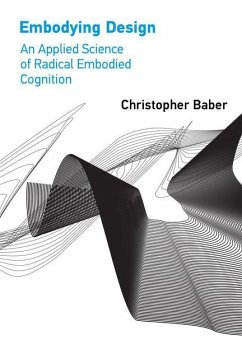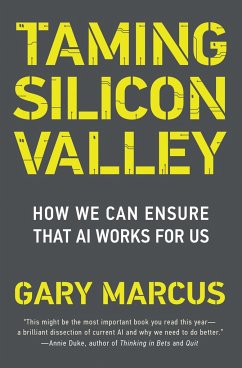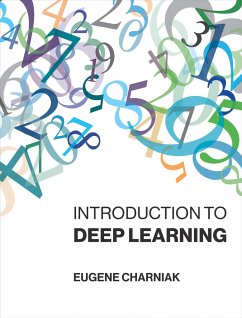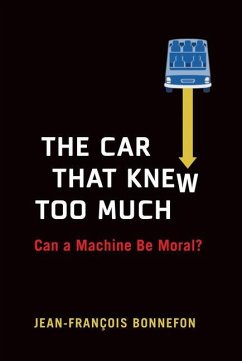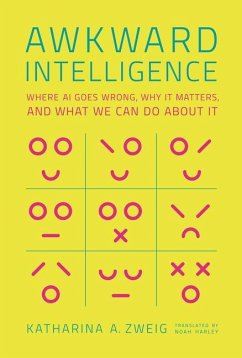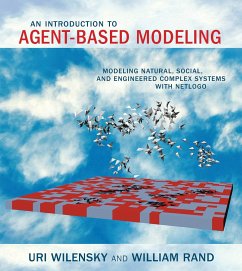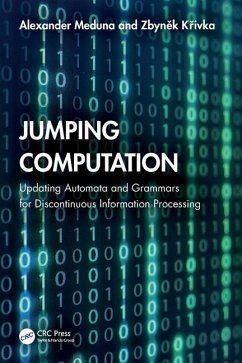
Algorithm Design
Pearson New International Edition

PAYBACK Punkte
68 °P sammeln!
August 6, 2009 Author, Jon Kleinberg, was recently cited in the New York Times for his statistical analysis research in the Internet age.
Algorithm Design introduces algorithms by looking at the real-world problems that motivate them. The book teaches students a range of design and analysis techniques for problems that arise in computing applications. The text encourages an understanding of the algorithm design process and an appreciation of the role of algorithms in the broader field of computer science.
Features + Benefits
Focus on problem analysis and design techniques.
Discussion is grounded in concrete problems and examples rather than abstract presentation of principles, with representative problems woven throughout the text.
Over 200 well crafted problems from companies such as Yahoo!® and Oracle®. Each problem has been class tested for usefulness and accuracy in the authors' own undergraduate algorithms courses.
Broad coverage of algorithms for dealing with NP-hard problems and the application of randomization, increasingly important topics in algorithms.
Algorithm Design
Jon Kleinberg and Eva Tardos
Table of Contents
1 Introduction: Some Representative Problems
1.1 A First Problem: Stable Matching
1.2 Five Representative Problems
Solved Exercises
Excercises
Notes and Further Reading
2 Basics of Algorithms Analysis
2.1 Computational Tractability
2.2 Asymptotic Order of Growth Notation
2.3 Implementing the Stable Matching Algorithm using Lists and Arrays
2.4 A Survey of Common Running Times
2.5 A More Complex Data Structure: Priority Queues
Solved Exercises
Exercises
Notes and Further Reading
3 Graphs
3.1 Basic Definitions and Applications
3.2 Graph Connectivity and Graph Traversal
3.3 Implementing Graph Traversal using Queues and Stacks
3.4 Testing Bipartiteness: An Application of Breadth-First Search
3.5 Connectivity in Directed Graphs
3.6 Directed Acyclic Graphs and Topological Ordering
Solved Exercises
Exercises
Notes and Further Reading
4 Divide and Conquer
4.1 A First Recurrence: The Mergesort Algorithm
4.2 Further Recurrence Relations
4.3 Counting Inversions
4.4 Finding the Closest Pair of Points
4.5 Integer Multiplication
4.6 Convolutions and The Fast Fourier Transform
Solved Exercises
Exercises
Notes and Further Reading
5 Greedy Algorithms
5.1 Interval Scheduling: The Greedy Algorithm Stays Ahead
5.2 Scheduling to Minimize Lateness: An Exchange Argument
5.3 Optimal Caching: A More Complex Exchange Argument
5.4 Shortest Paths in a Graph
5.5 The Minimum Spanning Tree Problem
5.6 Implementing Kruskal's Algorithm: The Union-Find Data Structure
5.7 Clustering
5.8 Huffman Codes and the Problem of Data Compression
*5.9 Minimum-Cost Arborescences: A Multi-Phase Greedy Algorithm
Solved Exercises
Excercises
Notes and Further Reading
6 Dynamic Programming
6.1 Weighted Interval Scheduling: A Recursive Procedure
6.2 Weighted Interval Scheduling: Iterating over Sub-Problems
6.3 Segmented Least Squares: Multi-way Choices
6.4 Subset Sums and Knapsacks: Adding a Variable
6.5 RNA Secondary Structure: Dynamic Programming Over Intervals
6.6 Sequence Alignment
6.7 Sequence Alignment in Linear Space
6.8 Shortest Paths in a Graph
6.9 Shortest Paths and Distance Vector Protocols
*6.10 Negative Cycles in a Graph
Solved Exercises
Exercises
Notes and Further Reading
7 Network Flow
7.1 The Maximum Flow Problem and the Ford-Fulkerson Algorithm
7.2 Maximum Flows and Minimum Cuts in a Network
7.3 Choosing Good Augmenting Paths
*7.4 The Preflow-Push Maximum Flow Algorithm
7.5 A First Application: The Bipartite Matching Problem
7.6 Disjoint Paths in Directed and Undirected Graphs
7.7 Extensions to the Maximum Flow Problem
7.8 Survey Design
7.9 Airline Scheduling
7.10 Image Segmentation
7.11 Project Selection
7.12 Baseball Elimination
*7.13 A Further Direction: Adding Costs to the Matching Problem
Solved Exercises
Exercises
Notes and Further Reading
8 NP and Computational Intractability
8.1 Polynomial-Time Reductions
8.2 Reductions via "Gadgets": The Satisfiability Problem
8.3 Efficient Certification and the Definition of NP
8.4 NP-Complete Problems
8.5 Sequencing Problems
8.6 Partitioning Problems
8.7 Graph Coloring
8.8 Numerical Problems
8.9 Co-NP and the Asymmetry of NP
8.10 A Partial Taxonomy of Hard Problems
Solved Exercises
Exercises
Notes and Further Reading
9 PSPACE: A Class of Problems Beyond NP
9.1 PSPACE
9.2 Some Hard Problems in PSPACE
9.3 Solving Quantified Problems and Games in Polynomial Space
9.4 Solving the Planning Problem in Polynomial Space
9.5 Proving Problems PSPACE-Complete
Solved Exercises
Exercises
Notes and Further Reading
10 Extending the Limits of Tractability
10.1 Finding Small Vertex Covers
10.2 Solving NP-Hard Problem on Trees
10.3 Coloring a Set of Circular Arcs
*10.4 Tree Decompositions of Graphs
*10.5 Constructing a Tree Decomposition
Solved Exercises
Exercises
Notes and Further Reading
11 Approximation Algorithms
11.1 Greedy Algorithms and Bounds on the Optimum: A Load Balancing Problem
11.2 The Center Selection Problem
11.3 Set Cover: A General Greedy Heuristic
11.4 The Pricing Method: Vertex Cover
11.5 Maximization via the Pricing method: The Disjoint Paths Problem
11.6 Linear Programming and Rounding: An Application to Vertex Cover
*11.7 Load Balancing Revisited: A More Advanced LP Application
11.8 Arbitrarily Good Approximations: the Knapsack Problem
Solved Exercises
Exercises
Notes and Further Reading
12 Randomized Algorithms
12.1 A First Application: Contention Resolution
12.2 Finding the Global Minimum Cut
12.3 Random Variables and their Expectations
12.4 A Randomized Approximation Algorithm for MAX 3-SAT
12.5 Randomized Divide-and-Conquer: Median-Finding and Quicksort
12.6 Hashing: A Randomized Implementation of Dictionaries
12.7 Finding the Closest Pair of Points: A Randomized Approach
12.8 Randomized Caching
12.9 Chernoff Bounds
12.10 Load Balancing
*12.11 Packet Routing
12.12 Background: Some Basic Probability Definitions
Solved Exercises
Exercises
Notes and Further Reading
13 Local Search
13.1 The Landscape of an Optimization Problem
13.2 The Metropolis Algorithm and Simulated Annealing
13.3 An Application of Local Search to Hopfield Neural Networks
13.4 Maximum Cut Approximation via Local Search
13.5 Choosing a Neighbor Relation
*13.6 Classification via Local Search
13.7 Best-Response Dynamics and Nash Equilibria
Solved Exercises
Exercises
Notes a
Algorithm Design introduces algorithms by looking at the real-world problems that motivate them. The book teaches students a range of design and analysis techniques for problems that arise in computing applications. The text encourages an understanding of the algorithm design process and an appreciation of the role of algorithms in the broader field of computer science.
Features + Benefits
Focus on problem analysis and design techniques.
Discussion is grounded in concrete problems and examples rather than abstract presentation of principles, with representative problems woven throughout the text.
Over 200 well crafted problems from companies such as Yahoo!® and Oracle®. Each problem has been class tested for usefulness and accuracy in the authors' own undergraduate algorithms courses.
Broad coverage of algorithms for dealing with NP-hard problems and the application of randomization, increasingly important topics in algorithms.
Algorithm Design
Jon Kleinberg and Eva Tardos
Table of Contents
1 Introduction: Some Representative Problems
1.1 A First Problem: Stable Matching
1.2 Five Representative Problems
Solved Exercises
Excercises
Notes and Further Reading
2 Basics of Algorithms Analysis
2.1 Computational Tractability
2.2 Asymptotic Order of Growth Notation
2.3 Implementing the Stable Matching Algorithm using Lists and Arrays
2.4 A Survey of Common Running Times
2.5 A More Complex Data Structure: Priority Queues
Solved Exercises
Exercises
Notes and Further Reading
3 Graphs
3.1 Basic Definitions and Applications
3.2 Graph Connectivity and Graph Traversal
3.3 Implementing Graph Traversal using Queues and Stacks
3.4 Testing Bipartiteness: An Application of Breadth-First Search
3.5 Connectivity in Directed Graphs
3.6 Directed Acyclic Graphs and Topological Ordering
Solved Exercises
Exercises
Notes and Further Reading
4 Divide and Conquer
4.1 A First Recurrence: The Mergesort Algorithm
4.2 Further Recurrence Relations
4.3 Counting Inversions
4.4 Finding the Closest Pair of Points
4.5 Integer Multiplication
4.6 Convolutions and The Fast Fourier Transform
Solved Exercises
Exercises
Notes and Further Reading
5 Greedy Algorithms
5.1 Interval Scheduling: The Greedy Algorithm Stays Ahead
5.2 Scheduling to Minimize Lateness: An Exchange Argument
5.3 Optimal Caching: A More Complex Exchange Argument
5.4 Shortest Paths in a Graph
5.5 The Minimum Spanning Tree Problem
5.6 Implementing Kruskal's Algorithm: The Union-Find Data Structure
5.7 Clustering
5.8 Huffman Codes and the Problem of Data Compression
*5.9 Minimum-Cost Arborescences: A Multi-Phase Greedy Algorithm
Solved Exercises
Excercises
Notes and Further Reading
6 Dynamic Programming
6.1 Weighted Interval Scheduling: A Recursive Procedure
6.2 Weighted Interval Scheduling: Iterating over Sub-Problems
6.3 Segmented Least Squares: Multi-way Choices
6.4 Subset Sums and Knapsacks: Adding a Variable
6.5 RNA Secondary Structure: Dynamic Programming Over Intervals
6.6 Sequence Alignment
6.7 Sequence Alignment in Linear Space
6.8 Shortest Paths in a Graph
6.9 Shortest Paths and Distance Vector Protocols
*6.10 Negative Cycles in a Graph
Solved Exercises
Exercises
Notes and Further Reading
7 Network Flow
7.1 The Maximum Flow Problem and the Ford-Fulkerson Algorithm
7.2 Maximum Flows and Minimum Cuts in a Network
7.3 Choosing Good Augmenting Paths
*7.4 The Preflow-Push Maximum Flow Algorithm
7.5 A First Application: The Bipartite Matching Problem
7.6 Disjoint Paths in Directed and Undirected Graphs
7.7 Extensions to the Maximum Flow Problem
7.8 Survey Design
7.9 Airline Scheduling
7.10 Image Segmentation
7.11 Project Selection
7.12 Baseball Elimination
*7.13 A Further Direction: Adding Costs to the Matching Problem
Solved Exercises
Exercises
Notes and Further Reading
8 NP and Computational Intractability
8.1 Polynomial-Time Reductions
8.2 Reductions via "Gadgets": The Satisfiability Problem
8.3 Efficient Certification and the Definition of NP
8.4 NP-Complete Problems
8.5 Sequencing Problems
8.6 Partitioning Problems
8.7 Graph Coloring
8.8 Numerical Problems
8.9 Co-NP and the Asymmetry of NP
8.10 A Partial Taxonomy of Hard Problems
Solved Exercises
Exercises
Notes and Further Reading
9 PSPACE: A Class of Problems Beyond NP
9.1 PSPACE
9.2 Some Hard Problems in PSPACE
9.3 Solving Quantified Problems and Games in Polynomial Space
9.4 Solving the Planning Problem in Polynomial Space
9.5 Proving Problems PSPACE-Complete
Solved Exercises
Exercises
Notes and Further Reading
10 Extending the Limits of Tractability
10.1 Finding Small Vertex Covers
10.2 Solving NP-Hard Problem on Trees
10.3 Coloring a Set of Circular Arcs
*10.4 Tree Decompositions of Graphs
*10.5 Constructing a Tree Decomposition
Solved Exercises
Exercises
Notes and Further Reading
11 Approximation Algorithms
11.1 Greedy Algorithms and Bounds on the Optimum: A Load Balancing Problem
11.2 The Center Selection Problem
11.3 Set Cover: A General Greedy Heuristic
11.4 The Pricing Method: Vertex Cover
11.5 Maximization via the Pricing method: The Disjoint Paths Problem
11.6 Linear Programming and Rounding: An Application to Vertex Cover
*11.7 Load Balancing Revisited: A More Advanced LP Application
11.8 Arbitrarily Good Approximations: the Knapsack Problem
Solved Exercises
Exercises
Notes and Further Reading
12 Randomized Algorithms
12.1 A First Application: Contention Resolution
12.2 Finding the Global Minimum Cut
12.3 Random Variables and their Expectations
12.4 A Randomized Approximation Algorithm for MAX 3-SAT
12.5 Randomized Divide-and-Conquer: Median-Finding and Quicksort
12.6 Hashing: A Randomized Implementation of Dictionaries
12.7 Finding the Closest Pair of Points: A Randomized Approach
12.8 Randomized Caching
12.9 Chernoff Bounds
12.10 Load Balancing
*12.11 Packet Routing
12.12 Background: Some Basic Probability Definitions
Solved Exercises
Exercises
Notes and Further Reading
13 Local Search
13.1 The Landscape of an Optimization Problem
13.2 The Metropolis Algorithm and Simulated Annealing
13.3 An Application of Local Search to Hopfield Neural Networks
13.4 Maximum Cut Approximation via Local Search
13.5 Choosing a Neighbor Relation
*13.6 Classification via Local Search
13.7 Best-Response Dynamics and Nash Equilibria
Solved Exercises
Exercises
Notes a
August 6, 2009 Author, Jon Kleinberg, was recently cited in the for his statistical analysis research in the Internet age. Algorithm Design introduces algorithms by looking at the real-world problems that motivate them. The book teaches students a range of design and analysis techniques for problems that arise in computing applications. The text encourages an understanding of the algorithm design process and an appreciation of the role of algorithms in the broader field of computer science.
Dieser Artikel kann nur an eine deutsche Lieferadresse ausgeliefert werden.





